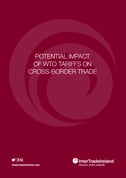Published: June 2017
Introduction
The nature of the trade arrangements that will be in place following the exit of the UK from the EU is currently unknown and will be the subject of considerable negotiation over the coming years. To inform this process, it is useful to have information on the current trading patterns and how different elements of alternative trade arrangements might impact on overall trade flows and how these might be distributed across different sectors and products. Businesses across the island of Ireland are currently highly integrated with products potentially crossing the border multiple times during different stages of processing. It is therefore particularly exposed to even temporary disruptions to trade or increases in trading costs as a particularly closely knit example of the European single market.
In the absence of a specific trade deal being agreed, the tariffs applied to third countries under World Trade Organisation (WTO) arrangements represent a fall-back scenario for goods trade. Although this may be considered a worst case scenario, it is a useful exercise to examine the impact of these tariffs and other trade barriers in order to understand the parameters in which
trade negotiations would operate. Trade in services does not have a similar fall-back set of tariffs or trade restrictions and data on services trade is more limited so this paper focuses entirely on goods trade.
Although some existing research exists on the overall impact of a WTO scenario for post-Brexit UK-EU trade, such as the analysis by Lawless and Morgenroth (2016), the different structure of cross-border trade compared to overall Ireland-UK trade means that the results they provide are unlikely to accurately capture the cross-border impact. That previous analysis took the 5,200 products listed in the EU external tariff schedule and applied them symmetrically to EU-UK trade. This work showed that the effective tariff rates ranged from 2% to 11% by country. Across sectors, the variation was more dramatic, ranging from 0% to 50% reflecting the differences in products traded.
This paper uses a similar approach to Lawless and Morgenroth but tailors it to the specific composition of cross-border trade and, in addition, extends the methodology to take into account exchange rate movement effects and other potential new costs to post-Brexit trade flows arising from non-tariff barriers. The wide variation in tariff rates, and hence heterogeneity in sectoral impacts, is the reason why an in-depth examination of the existing structure of trade flows is crucial to providing a tailored estimate of the impact of the possible introduction of tariffs.
After combining the tariff and non-tariff barrier estimates with the current trade structure, the next step of the research is to examine how the tariff induced price increases might change the demand for the currently traded products. The total impact on trade will be a combination of the size of the price increase caused by the tariff and the sensitivity of trade to price changes. To do this, we will use international elasticity response estimates of trade to price changes at a sector level to calculate the effect on cross-border trade flows. As the price effect can be re-enforced or mitigated by exchange rate movements, we build in an estimate to reflect the impact of changes in the euro-sterling exchange rate on cross-border trade.

